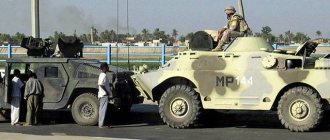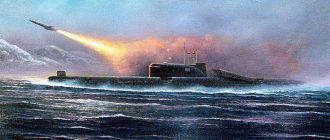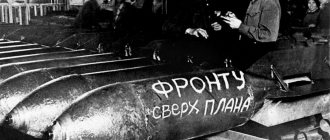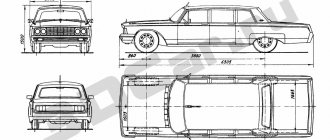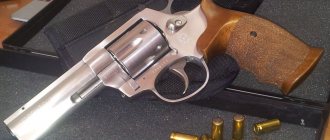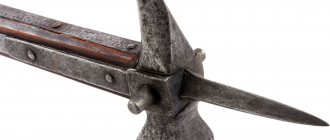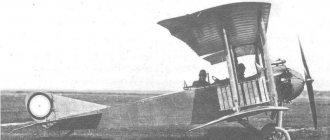Submarines (submarines) are ships of a separate class that can dive and swim underwater for a long time.
The special design of the submarine withstands high pressure of the water mass, and also provides the necessary streamlining and water resistance. The principle of submersion and ascent of a submarine corresponds to Archimedes' law. The design of a submarine is highly complex. A separate class of submarines is used in the following areas:
- Military. Delivering strategic nuclear strikes, conducting reconnaissance, landing sabotage groups. Modern nuclear submarine cruisers are equipped with mines, torpedoes, missiles and radio-electronic weapons. Man-portable anti-aircraft missile systems are used to protect submarines on the surface. In peacetime, nuclear submarines can be used to launch artificial Earth satellites into low orbits.
- Scientific. Study of the geomagnetic field, as well as the study of underwater flora and fauna.
- Tourist. Excursions and exploration of the underwater world at depths of up to 100 m. Tourist submarines are equipped with wide acrylic windows.
- Criminal. Small submarines are used by Colombian criminal groups to transport drugs and other illicit items.
The principle of operation of a submarine is as follows: immersion is carried out as a result of filling the bow, stern and middle main ballast tanks (CBT) with water. The ascent of the ship is carried out by blowing the indicated containers with compressed air. CGBs can be filled and emptied simultaneously or one at a time.
Scheme of using CPG
For urgent depth gain, a special rapid immersion tank located in a durable casing can be used. How does a submarine float? The course and depth of the submarine are adjusted using special steering devices (horizontal and vertical). The speed of the submarine is controlled by the speed of the propeller.
Operating principle of the submarine
The submarine's submersion and ascent system includes ballast and auxiliary tanks, as well as connecting pipelines and fittings. The main element here is the main ballast tanks, by filling them with water the main buoyancy reserve of the submarine is extinguished. All tanks are included in the bow, stern and middle groups. They can be filled and purged one at a time or simultaneously.
The submarine has trim tanks necessary to compensate for the longitudinal displacement of cargo. The ballast between trim tanks is blown using compressed air or pumped using special pumps. Trimming is the name of the technique, the purpose of which is to “balance” the submerged submarine.
Nuclear submarines are divided into generations. The first (50th) is characterized by relatively high noise and imperfect hydroacoustic systems. The second generation was built in the 60s and 70s: the hull shape was optimized to increase speed. The boats of the third are larger, and they also have electronic warfare equipment. The fourth generation nuclear submarines are characterized by an unprecedented low noise level and advanced electronics. The appearance of the fifth generation boats is being worked out these days.
An important component of any submarine is the air system. Diving, surfacing, removing waste - all this is done using compressed air. The latter is stored under high pressure on board the submarine: this way it takes up less space and allows you to accumulate more energy. High-pressure air is in special cylinders: as a rule, its quantity is monitored by a senior mechanic. Compressed air reserves are replenished upon ascent. This is a long and labor-intensive procedure that requires special attention. To ensure that the crew of the boat has something to breathe, air regeneration units are installed on board the submarine, allowing them to obtain oxygen from seawater.
The hardships of service
The authentic “Novosibirsk Komsomolets” conveys a feeling of cramped conditions and hardships of service as submariners. A small corridor is squeezed into the middle of the 90-meter ship, where two sailors can barely pass each other sideways. The submarine consists of seven compartments and three decks. The bow compartment is filled with 24 huge eight-meter torpedoes. The diameter of the underwater projectile is more than half a meter and weighs over two tons. Each of the torpedoes is capable of sinking an enemy ship, taking into account a combat charge of several hundred kilograms. Personal space is a luxury for a submariner. All 78 sailors of the Novosibirsk Komsomolets could simultaneously be on an autonomous cruise for 80 days. Some torpedomen lived right in the fighting compartment. Between the shells, they hung canvas bunks, or in fact hammocks, from the ceiling with chains. Here they had to sleep and eat. “Now the torpedoes are empty and without explosives, so you can touch them if you wish. It’s safe and not prohibited,” says the guide. But the schoolchildren are confused and hesitant.
A submariner's work can take up most of the day. Moreover, there is no division into day and night; time is divided into shifts. Stanislav Bogomolov
Researcher at the Museum of the History of the Russian Navy
“While some sailors are sleeping, others are on shift - doing unskilled work. For example, they scrub the deck or peel potatoes. The third part of the crew is on watch at this time,” said Stanislav Bogomolov.
The crew changes every four hours. It turns out that submariners sleep eight hours a day in fits and starts.
Photo: Moscow 24/Anton Velikzhanin
Premier League: what are they?
A nuclear boat has a nuclear power plant (where, in fact, the name comes from). Nowadays, many countries also operate diesel-electric submarines (submarines). The level of autonomy of nuclear submarines is much higher, and they can perform a wider range of tasks. The Americans and British have stopped using non-nuclear submarines altogether, while the Russian submarine fleet has a mixed composition. In general, only five countries have nuclear submarines. In addition to the USA and the Russian Federation, the “club of the elite” includes France, England and China. Other maritime powers use diesel-electric submarines.
The future of the Russian submarine fleet is connected with two new nuclear submarines. We are talking about multi-purpose boats of Project 885 “Yasen” and strategic missile submarines 955 “Borey”. Eight units of Project 885 boats will be built, and the number of Boreys will reach seven. The Russian submarine fleet will not be comparable to the American one (the United States will have dozens of new submarines), but it will occupy second place in the world rankings.
Russian and American boats differ in their architecture. The United States makes its nuclear submarines single-hull (the hull both resists pressure and has a streamlined shape), while Russia makes its nuclear submarines double-hulled: in this case, there is an internal, rough, durable hull and an external, streamlined, lightweight one. On Project 949A Antey nuclear submarines, which included the infamous Kursk, the distance between the hulls is 3.5 m. It is believed that double-hull boats are more durable, while single-hull boats, all other things being equal, have less weight. In single-hull boats, the main ballast tanks, which ensure ascent and submersion, are located inside a durable hull, while in double-hull boats, they are inside a lightweight outer hull. Every domestic submarine must survive if any compartment is completely flooded with water - this is one of the main requirements for submarines.
In general, there is a tendency to switch to single-hull nuclear submarines, since the latest steel from which the hulls of American boats are made allows them to withstand enormous loads at depth and provides the submarine with a high level of survivability. We are talking, in particular, about high-strength steel grade HY-80/100 with a yield strength of 56-84 kgf/mm. Obviously, even more advanced materials will be used in the future.
There are also boats with a mixed hull (when a light hull only partially covers the main one) and multi-hulls (several strong hulls inside a light one). The latter includes the domestic missile submarine cruiser Project 941, the largest nuclear submarine in the world. Inside its lightweight body are five durable housings, two of which are the main ones. Titanium alloys were used to make durable cases, and steel alloys were used for lightweight ones. It is covered with a non-resonant anti-location soundproof rubber coating weighing 800 tons. This coating alone weighs more than the American nuclear submarine NR-1. Project 941 is truly a gigantic submarine. Its length is 172 and its width is 23 m. There are 160 people on board.
You can see how different nuclear submarines are and how different their “contents” are. Now let’s take a closer look at several domestic submarines: boats of project 971, 949A and 955. All of these are powerful and modern submarines serving in the Russian Navy. The boats belong to three different types of nuclear submarines, which we discussed above.
On your own oxygen
In the ED-VVD scheme, as in REDO, the main part of the exhaust gases, having passed through the gas cooler and separator, entered the gas mixer, where oxygen was added to it, and then this mixture burned in the diesel cylinders.
The rest of the exhaust gases were taken by the compressor and thrown overboard through special spray devices into the propeller jet.
In the post-war period, according to the documentation of SKB-143 (now the Marine Engineering Bureau "Malachite" in St. Petersburg), the boat, on which a power plant was installed before the war according to the REDO scheme, was converted to the ED-VVD scheme.
During 1950-1953, this submarine underwent state tests.
At the same time, a submarine with an ED-KhPI type power plant also underwent such tests.
The test results showed that the ED-VVD cycle had no advantages compared to ED-CPI.
In addition, a boat with an ED-VVD in a submerged position left a noticeable gas bubble trail, which was how it was unmasked.
Photo 4. Submarine M-401 (S-135) with ED-KhPI engine during testing
These circumstances led to the cessation of work on this topic (as subsequent experience showed, concerns about the unmasking effect of the gas bubble trail were exaggerated).
For submarines with a power plant according to the ED-KhPI scheme, fate was more favorable: they were accepted into the USSR Navy.
The development of the project of this submarine was carried out in 1938-1939 in a special NKVD design bureau, the so-called “sharashka”, by “convict engineers”.
The design bureau was located on the territory of Leningrad (now the territory of the state enterprise "Admiralty Shipyards", the city of St. Petersburg).
Tests of the submarine were carried out during the war in the Caspian Sea for several years, often interrupted due to accidents and equipment failures, and were completed at the end of 1945.
The creators of the new installation were faced with “surprises” at every step. They began with the loading of liquid oxygen.
Having no experience in this matter, the sailors began receiving liquid oxygen in the same way as they usually received fuel or fresh water: through a hose from a tank truck through a funnel.
The oxygen first evaporated and began to enter the boat container in the form of steam, then, after the hose cooled, films of liquid oxygen began to appear in the form of small pancakes.
One such “pancake” splashed out of the funnel onto the deck with an explosion. Oxygen intake was stopped.
As a result, a crack about a meter long appeared in the light hull of the submarine, and in the durable hull, in the area where the tank ventilation pipe exited, a crack also appeared as a result of the continuous bleeding of oxygen gas.
It turns out that the submarine had to be filled with liquid oxygen through a hose connected tightly to the tank.
Photo 5. Mortgage board for the M-352 submarine of the A615 project
There were great difficulties in adjusting the supply of oxygen gas when fuel consumption changed.
Neither automatic regulation of oxygen supply nor gas analyzers that constantly record the oxygen content in the gas mixture existed then.
Depending on the change in pressure in the gas-tight sealed compartments, the color of the gas environment changed.
The light brown color of the gas environment and the decrease in pressure in the compartment indicated an insufficient supply of oxygen.
If the pressure in the diesel compartments increased, indicating an excessive supply of oxygen, the color of the gas environment became pale blue.
The operator observed this change through special windows and opened or closed the oxygen supply valve.
Ensuring the gas tightness of the diesel engine turned out to be an intractable problem. Exhaust gas penetrated into the diesel compartment through leaks, fumes from fuel and oil leaks were added to it, and the risk of fire increased.
During the operation of the diesel engine and after it was stopped, people were prohibited from staying in the engine compartments without isolating devices.
Ventilation of the compartments was carried out by transferring diesel engines to the surface cycle.
During the tests, there were several cases of explosions (pops) that led to fires in the diesel compartments.
Detailed studies and explanations of these phenomena were not carried out; the maintenance personnel were usually blamed for poor maintenance of the power plant.
In 1942, during factory sea trials of a submarine with ED-KhPI, a serious accident occurred.
When the submarine was in a submerged position while the diesel engines were operating in a closed cycle, the operator at the control panel discovered that the valve in the oxygen supply network was jammed in the open position, the pressure in the diesel compartment began to increase rapidly, and the color of the gas mixture became bluish.
The submarine commander decided to surface.
At this time, the author of the project V.S. Dmitrievsky saw a fire in the diesel compartment through the window and, without the commander’s permission, opened the door and entered the emergency compartment.
A few seconds later he jumped out of there with his clothes on fire - the fire in the diesel compartment continued.
Dmitrievsky, fearing an increase in pressure in the oxygen tank, arbitrarily opened the valve for bleeding oxygen into the central post, and a fire started there too.
Photo 6. The lead submarine of Project 615 - M-254 on the Neva River - after modernization and dismantling of the gun mount
After the boat surfaced, the valve to the central post was closed and the valve for bleeding oxygen overboard was opened, but the fire continued.
The commander ordered the personnel to leave the boat and move to the surface ship providing testing.
Many sailors received burns, and the burned V.S. Dmitrievsky could not be saved.
In 1946, work on the project was transferred to TsKB-18, where the designers and developers released from prison were transferred.
Based on generally positive tests, work began on creating an experimental submarine with an ED-KhPI power plant.
In 1948, upon completion of this work, a group of specialists was awarded the Stalin Prize.
In 1953, tests of the submarine with ED-KhPI were completed, the boat received the letter-numeric designation M-254 of Project 615 and became part of the USSR Navy.
Created on its basis, starting in 1956, serial boats, which were assigned the project number A615, belonged to the class of small torpedo submarines.
When designing them, one of the indispensable requirements was the need to ensure their transportation by rail.
The ships of the A615 project were significantly superior to diesel submarines in speed (they could reach speeds of up to 10 knots), in the duration of scuba diving and in the maximum diving depth.
In terms of architecture, they were one and a half hulls.
The bow and stern parts of the durable (sealed) hull of the boat are not covered by a light (water-permeable) hull, which creates external contours and serves to accommodate the main ballast tanks (CHT), ensuring the immersion and ascent of the boat; the most rational, according to modern ideas, layout scheme was used Central City Hospital.
In the double-sided space there were six tanks, of which No. 2 and No. 5 were kingless, and No. 1 and No. 6 and the middle group tanks (No. 3 and No. 4) were kingston.
Kingstons at the end of the Central City Hospital were important for ensuring unsinkability on the surface.
As with other domestic boats, the requirement of “single-compartment” surface unsinkability was met (the submarine remained afloat when any compartment of the pressure hull and two tanks of the Central City Hospital adjacent to one side were flooded).
The robust hull is divided by transverse bulkheads into seven compartments. The bulkheads that bounded the central post (third compartment) were designed for a pressure of 10 kg/cm2, the rest - for 1 kg/cm2.
The three-shaft main diesel power plant was located in the 4th, 5th and 6th compartments of the durable hull.
In compartment No. 5 there were two M50 diesel engines with a power of 900 hp each. s., working on the side lines of the shafts, and in compartment No. 6 - one 32D diesel engine with a power of 900 p. s., working on the center line of the shaft.
All diesel engines were placed in gas-tight enclosures and could operate in a closed cycle (in the submerged position of the boat).
Light, high-speed M50 diesel engines, developed at one time for aircraft, could operate in afterburner mode, and therefore had a short service life of 300 hours.
The control post was located at the aft bulkhead of the 4th compartment. Folding seats were installed here for the assistant commander of 6Ch-5 and the chemical operator.
The control post for the 32D diesel engine was located in the 5th compartment. They were provided with long-term surface and underwater travel, as well as charging the battery and sailing under the RPD.
All diesel engines were installed on shock absorbers, and special attention was paid to reducing noise when the 32D operated in a submerged position (in a closed cycle).
Liquid oxygen, which ensures the operation of the engines, was placed in the hold of the 4th compartment in two cylindrical brass tanks with a capacity of 4.3 tons each.
The operating pressure of oxygen in the tanks was 13 atm. Thermal insulation of the tanks was provided by slag wool.
Above the tanks, on both sides, up to the ceiling of the compartment, there were two gas filter baffles with a solid lime chemical absorber (7.2 tons each).
Photo 7. Project A615 submarine on a voyage on the surface
Liquid oxygen, passing through an electrically heated evaporator located in the 4th compartment, was supplied through an automatic dosing regulator through a pipeline into the return gas mixer, and after mixing, the gas mixture entered the diesel engine enclosures.
On the centerline of the shaft in compartment No. 7 there was a PG-106 electric propeller motor with a power of 68 hp. s., which could be powered by a 60-cell battery located in the hold of the 2nd compartment.
Taking into account the test results in the Caspian Sea, when creating the ED-KhPI power plant for Project 615 boats, considerable attention was paid to monitoring the state of the gas environment in the engine enclosures.
An automatic oxygen dispenser (ARM), quick-closing oxygen supply valves, and oxygen percentage gas analyzers were developed and installed.
When diesel engines operated in a closed cycle, a vacuum of 100 to 500 mm of water was maintained in the engine enclosures. Art.
Filters were installed in the enclosures of the 32D diesel engine to remove toxic gases in order to allow personnel to visit the enclosure after stopping the diesel engine in a submerged position.
Nuclear submarines are divided according to their purpose:
· SSBN (Strategic Missile Submarine Cruiser). As part of the nuclear triad, these submarines carry ballistic missiles with nuclear warheads. The main targets of such ships are military bases and enemy cities. The SSBN includes the new Russian nuclear submarine 955 Borei. In America, this type of submarine is called SSBN (Ship Submarine Ballistic Nuclear): this includes the most powerful of these submarines - the Ohio-class boat. To accommodate the entire lethal arsenal on board, SSBNs are designed taking into account the requirements of a large internal volume. Their length often exceeds 170 m - this is noticeably longer than the length of multi-purpose submarines.
LARK K-186 "Omsk" pr.949A OSCAR-II with open covers of launchers of the Granit missile system. The boats of the project in the Navy have the unofficial name “Baton” - for the shape of the hull and impressive size.
· PLAT (nuclear torpedo submarine). Such boats are also called multi-purpose. Their purpose: the destruction of ships, other submarines, tactical targets on the ground and the collection of intelligence data. They are smaller than SSBNs and have better speed and mobility. PLATs can use torpedoes or high-precision cruise missiles. Such nuclear submarines include the American Los Angeles or the Soviet/Russian MPLATRK Project 971 Shchuka-B.
Project 941 Akula submarine
The American Seawolf is considered the most advanced multi-purpose nuclear submarine. Its main feature is the highest level of stealth and deadly weapons on board. One such submarine carries up to 50 Harpoon or Tomahawk missiles. There are also torpedoes. Due to the high cost, the US Navy received only three of these submarines.
Project 941 Akula submarine
· SSGN (nuclear submarine with cruise missiles). This is the smallest group of modern nuclear submarines. This includes the Russian 949A Antey and some American Ohio missiles converted into cruise missile carriers. The SSGN concept has something in common with multi-purpose nuclear submarines. Submarines of the SSGN type, however, are larger - they are large floating underwater platforms with high-precision weapons. In the Soviet/Russian navy these boats are also called “aircraft carrier killers”.
Living compartment
Commander's cabin. The entrances to the cabins are sealed with glass. In fact, there were naturally no glass doors inside the submarine. This was done specifically for ease of inspection. Only the commander had a washbasin; the rest of the submariners did not wash or brush their teeth.
Officer's cabins accommodated 2 officers each
Nothing like that, glamorous
Mess for officers. If necessary, the table was wiped with alcohol and the dining room was turned into an operating room.
Doctor's cabin
The latrine (toilet) was closed. It was previously open, but visitors tried to use it for its intended purpose.
Inside a submarine
It is difficult to examine in detail the design of all main types of nuclear submarines, but it is quite possible to analyze the design of one of these boats. It will be the Project 949A submarine “Antey”, a landmark (in every sense) for the Russian fleet. To increase survivability, the creators duplicated many important components of this nuclear submarine. These boats received a pair of reactors, turbines and propellers. The failure of one of them, according to the plan, should not be fatal for the boat. The submarine's compartments are separated by intercompartment bulkheads: they are designed for a pressure of 10 atmospheres and are connected by hatches that can be sealed if necessary. Not all domestic nuclear submarines have so many compartments. The Project 971 multipurpose nuclear submarine, for example, is divided into six compartments, and the new Project 955 SSBN is divided into eight.
Submarine "Kursk"
The infamous Kursk belongs to the Project 949A boats. This submarine sank in the Barents Sea on August 12, 2000. All 118 crew members on board became victims of the disaster. Many versions of what happened have been put forward: the most likely of all is the explosion of a 650 mm torpedo stored in the first compartment. According to the official version, the tragedy occurred due to a leak of a torpedo fuel component, namely hydrogen peroxide.
The Project 949A nuclear submarine has a very advanced (by the standards of the 80s) apparatus, including the MGK-540 Skat-3 hydroacoustic system and many other systems. The boat is also equipped with an automated Symphony-U navigation system that has increased accuracy, increased range and a large volume of processed information. Most of the information about all these complexes is kept secret.
Soviet legacy
In Moscow, on the opposite bank from the Northern River Station, the diesel-electric submarine B-396 Novosibirsk Komsomolets is moored at the pier. The resin-colored submarine with a white waterline stripe along the perimeter and circles of torpedo compartments on the bow looks like it came straight out of a Hollywood blockbuster about Soviet submarines.
“Novosibirsk Komsomolets” was built in 1980 in Nizhny Novgorod. Since 1981, the submarine served in combat with the 4th submarine squadron of the Northern Fleet. The submarine did not participate in hostilities, but made military campaigns in the Mediterranean Sea, the South and North Atlantic, sailed off the west coast of Africa, as well as in the Norwegian and Barents Seas.
After being decommissioned from the Navy in 1998, the boat was lucky. Unlike many others, it was not cut into scrap metal, but was bought by the Moscow authorities. From 2000 to 2001, the submarine was refitted in Severodvinsk by order of the Moscow government. On July 26, 2006, a museum was opened there.
Among the visitors there are cadets from military schools and foreigners. Before the pandemic, groups from the UAE, China, and Japan visited here. One Japanese man liked the submarine so much that he translated the excursion text into Japanese for the museum’s audio guide free of charge. Now the museum also has an audio guide in Russian and Spanish, but not yet in English.
Most of the visitors are schoolchildren and their parents. Many of them come as part of the city Olympiad “Museums. Parks. Estates." Children answer questions about the museum's topics, and the school records this in their portfolio.
Photo: Moscow 24/Anton Velikzhanin
“Where is the gyrocompass? You need to find this on the Internet,” the mother of one of the students tries to cheat. But there is no Internet access on the submarine, which shocks many teenagers. A weak connection appears only in the outer compartments near the exits to the pier. “All submarines consist of two hulls, like a thermos. The Novosibirsk Komsomolets outer casing consists of 1.5 centimeters of high-strength steel. Plus a thick layer of rubber for sound insulation, making it harder for other people’s acoustics to detect. The thickness of the internal hull of the B-396 is four centimeters of steel,” said Stanislav Bogomolov, a researcher at the Museum of the History of the Russian Navy, who led the tour. When the submarine was equipped as a museum, 70% of the equipment was removed for the convenience of visitors. The main change was the creation of doorways between the submarine's compartments. They were equipped so that the museum could be visited by wheelchair users. In the original, the compartments are connected by round hatches, like on the ISS.
Photo: Moscow 24/Anton Velikzhanin
Compartments of the Project 949A Antey nuclear submarine:
First compartment:
It is also called bow or torpedo. This is where the torpedo tubes are located. The boat has two 650 mm and four 533 mm torpedo tubes, and in total there are 28 torpedoes on board the submarine. The first compartment consists of three decks. The combat stock is stored on racks designed for this purpose, and torpedoes are fed into the apparatus using a special mechanism. There are also batteries located here, which are separated from the torpedoes by special flooring for safety reasons. The first compartment usually houses five crew members.
Second compartment:
This compartment on submarines of projects 949A and 955 (and not only on them) plays the role of the “brain of the boat”. This is where the central control panel is located, and this is where the submarine is controlled. There are consoles for hydroacoustic systems, microclimate regulators and navigation satellite equipment. There are 30 crew members serving in the compartment. From it you can get into the control room of the nuclear submarine, designed for monitoring the surface of the sea. There are also retractable devices: periscopes, antennas and radars.
Project 955 nuclear submarine
Third compartment:
The third is the radio-electronic compartment. Here, in particular, there are multi-profile communication antennas and many other systems. The equipment of this compartment allows receiving target indications, including from space. After processing, the received information is entered into the ship's combat information and control system. Let us add that the submarine rarely makes contact, so as not to be unmasked.
Fourth compartment:
This compartment is residential. Here the crew not only sleeps, but also spends their free time. There is a sauna, gym, showers and a common room for communal relaxation. In the compartment there is a room that allows you to relieve emotional stress - for this, for example, there is an aquarium with fish. In addition, in the fourth compartment there is a galley, or, in simple terms, a nuclear submarine kitchen.
Nuclear submarines with cruise missiles. Project 670 "Scat" (Charlie-I class)
Fifth compartment:
There is a diesel generator that generates energy here. Here you can also see an electrolysis installation for air regeneration, high-pressure compressors, a shore power supply panel, diesel fuel and oil reserves.
5 bis:
This room is needed for decontamination of crew members who worked in the reactor compartment. We are talking about removing radioactive substances from surfaces and reducing radioactive contamination. Due to the fact that there are two fifths of the compartment, confusion often occurs: some sources claim that the nuclear submarine has ten compartments, others say nine. Even though the last compartment is the ninth, there are ten of them in total on the nuclear submarine (including 5 bis).
Sixth compartment:
This compartment, one might say, is located in the very center of the nuclear submarine. It is of particular importance, because it is here that two OK-650V nuclear reactors with a capacity of 190 MW are located. The reactor belongs to the OK-650 series - a series of water-water nuclear reactors using thermal neutrons. The role of nuclear fuel is played by uranium dioxide, highly enriched in the 235th isotope. The compartment has a volume of 641 m³. Above the reactor there are two corridors that allow access to other parts of the nuclear submarine.
Seventh compartment:
It is also called turbine. The volume of this compartment is 1116 m³. This room is intended for the main distribution board; power plants; emergency control panel for the main power plant; as well as a number of other devices that ensure the movement of the submarine.
Eighth compartment:
This compartment is very similar to the seventh, and is also called the turbine compartment. The volume is 1072 m³. The power plant can be seen here; turbines that drive nuclear submarine propellers; a turbogenerator that provides the boat with electricity, and water desalination plants.
Ninth compartment:
This is an extremely small shelter compartment, with a volume of 542 m³, with an escape hatch. This compartment, in theory, will allow crew members to survive in the event of a disaster. There are six inflatable rafts (each designed for 20 people), 120 gas masks and rescue kits for individual ascent. In addition, the compartment contains: steering system hydraulics; high pressure air compressor; electric motor control station; lathe; combat post for reserve rudder control; shower and food supply for six days.
What does the autonomy of a nuclear submarine depend on?
Nuclear submarines and escort vessels
The advent of a nuclear reactor and an increase in the volume of the submarine hull after the appearance of a nuclear reactor on board made it possible to increase the payload by a factor of 10 compared with diesel submarines.
At the same time, so does the duration of autonomous travel. It is believed that the duration of an autonomous voyage, as a single voyage of a nuclear submarine is called, can reach six months: the task of patrolling the shores of a potential enemy takes approximately that long.
Moreover, many of the modern nuclear submarines are capable of staying under water for up to half of this time. And for the entire period, do not replenish supplies either from the shore or from support vessels.
However, the average voyage of the submarine fleet of all states is about 2-3 months.
In the recreation area of the nuclear submarine of project 941
Of these, at least a quarter of the time is spent on the surface, and at least half is spent in direct proximity to fire support ships and supply vessels, which are combined with nuclear submarines into a single combat (patrol/training) group.
The duration of the trip is limited based on operating experience, on which the supply of food, filters for fresh water and clean air is based.
The fact is that the main deterrent to long-term autonomous voyages of nuclear submarines is psychological. It is too difficult for a person to be in a confined space with a narrow group for a long time.
In addition, the navigation of a nuclear submarine requires constant monitoring and a lot of standard work; there is no time to relax. Otherwise, there would be ships that remain under water for years.
Electric motor compartment
The boat had 3 electric motors that were powered by batteries.
There is also a shower room here. Showers were taken once a week. We washed ourselves with sea water. For this purpose there were special shampoos that were washed in salt water. The linen was disposable. After the shower, a new set was issued, and dirty laundry was thrown overboard.
Central control center
The commander sat here
Computer. Based on the input data, taking into account any corrections, the computer calculated the course, distance, etc.
Torpedo launch control. There is no need to explain why the red button is needed.
Motor control. There were 3 of them in total. Accordingly, the boat had 3 propellers.
Hydroacoustics room for listening to the ocean
Navigator
Radar room
The lampshade, which is visible in the photo, was used not only for its intended purpose, but also to initiate newcomers. When the boat sank to 100 meters, cold sea water was taken from outside, poured into the lampshade and given to the newcomer to drink.
Battery compartment
This is where the batteries were located. I must say that the boat had 3 tiers. The tour takes place only along the upper one.
Galley (kitchen) The cook cooked 4 times a day to feed 78 people! The food on the submarine was very good. The daily diet of submariners includes the following products:
- red caviar – 5 g
- sturgeon balyk – 5 g
- salted salmon - 10 g
- sprats - 15 g
- hard smoked sausage – 15 g
- egg
- honey - 5 g
- chocolate – 15 g
- cheese, milk, cottage cheese
- fruits, juices, vegetables
- saltiness, fresh meat on the bones - 400 g
- fresh fish – 240 g
- white bread - 600 g
- black bread - 400 g
- canned fish, canned meat, canned vegetables
- dry wine - 50 g.
Moreover, the range of dishes was very rich. For example, if the cook has prepared buckwheat porridge, then the next time he will cook it in about a month. Only the officers had a canteen. Ordinary sailors ate while sitting on their beds. Meals are taken in shifts between shifts four times a day: breakfast, lunch, dinner, evening tea (hot first, second - at lunch and dinner). 2 assistants served the food, and they also washed the dishes.
The sailors wore these light sandals. Kirzachs are not needed on a submarine.
It should be noted that the museum is superbly done. On the monitors you can watch a 3D video of a submarine attack
Boat model in scale 1:40
Diesel compartment
One of three diesel engines. Power of each is 1700 hp.
The boat turned on the diesel engines on the surface. They charged the batteries in 10 hours. Then the boat sank and was already under water powered by electric motors. She swam underwater for up to 10 days, after which she floated up to recharge the batteries using a diesel engine and take in air. The temperature inside reached 70 degrees!


